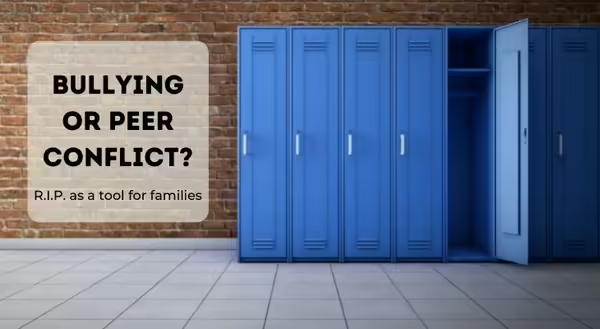
As children return to schools and classrooms this fall after a year of a variety of learning environments, many parents and caregivers may find themselves concerned about bullying. Recent research indicated, not surprisingly, that rates of school bullying dropped during the pandemic – likely as a result of many students participating in remote learning environments. And, as students spend more and more time in digital, on-line learning environments, the risk for cyberbullying can increase as well.
A concerned parent once approached me with a myriad of questions on bullying. Why was her child being excluded from the peer group? What about name calling – is that bullying? Why is her child being picked on? What can she do to help? As the questions went on, one in particular stood out to me: “Is this normal?” It became clear: this parent was having difficulty distinguishing between “normal” peer conflict and bullying.
Families have a plethora of resources to consult in the area of bullying. A google search of the term “bullying” will yield 348 million results in a matter of milliseconds. While there is no doubt a wealth of information on bullying, caregivers may ask themselves, “How do I tell the difference between bullying and normal peer conflict?”
One approach families can use to distinguish between peer conflict and bullying is using the acronym RIP. There are generally three components of bullying:
R – Repeated. The action of the bully is generally a repeated action, occurring time after time.
I – Intentional. The target does not knowingly provoke the bully and, as such, the bully is intentional with their behavior/actions.
P – Power Imbalance. In bullying situations, there is a real or perceived power imbalance between the two parties. This imbalance can be physical strength, access to information, or even popularity.
In contrast, “normal” peer conflicts differ from bullying situations in the following ways:
The children involved are of equal power or are friends.
The conflict that occurs is occasional or often accidental.
There is an equal emotional reaction to the conflict to both children and power or control is not being sought.
Having disagreements with peers is a normal developmental task of childhood; bullying, while it may be a common childhood experience, should not be tolerated. Trying to discern between the two may be difficult as a parent. It may be helpful to assess the situation closely – asking ourselves if the action is Repeated, Intentional, and involves a Power Imbalance.
Using the RIP concept is a great tool to help parents distinguish between bullying and peer conflict as response to each differs. Conflict can be a good thing for children to experience – helping them to learn how to resolve conflict, how to give and take, how to come to an agreement, and how to problem solve. Developing conflict resolution skills in children can teach how to listen to and work with others.
Parental response to bullying takes two main forms: support and report. Supporting your child means maintaining open lines of communication with your child, actively listening to their experiences, avoiding blame, and empowering him/her. Informing your child’s teacher or school of bullying incidents is also key.
For more information on responding to bullying situations, visit these excellent resources:
What Parent's Should Know about Bullying
The Parent's Guide to Cyberbullying
Meet the Author:
Karla Belzer is a family life educator serving in northwest Illinois since 2015. Prior to her work with Extension, she worked in health and human services for over 20 years. She specializes in mindfulness, social-emotional development, aging well throughout the lifespan, and educator professional development. She is passionate about helping people of all ages live their best life.